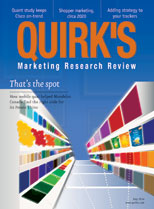Editor’s note: Carl Van Ostrand is the sales director for YouEye, a Mountain View, Calif., research firm.
You can get sized for clothing (including a bra) using just your smartphone. It’s true, but there’s also a bigger picture here.
It shouldn’t come as news that consumers are spending more time engaged with digital and mobile content in every aspect of their lives. Shopping, banking, socializing, ordering meals, finding news, booking trips, streaming media, “hailing” taxis – but the point is, if consumers are moving their spending to a digital and mobile world, then qualitative researchers need a way to observe, ask the “why” questions and achieve deep insights.
There are some new developments that are helping researchers keep pace better than you may think:
1. Consumers’ front-facing cameras are now being utilized for more than uploading videos and one-on-one moderated sessions. New technology is allowing for the full video, audio and screen capture of a consumer experience in the moment, while being observed and/or prompted with tasks and questions. This means that we can expose just about any audience to any digital stimuli (desktop and mobile Web sites, product marketing, packaging/branding, advertising/media, mock-ups, etc.) and walk them through a qualitative session.
2. But let’s move past the digital stimulus. Ever imagine watching and recording a mother make a snack for her children without launching a full home ethnography study? You now have a consumer direct interviewing device with full experience capture.
3. We’re starting to hear the rumblings of “big qual.” The challenge of capturing high volumes of qualitative data has been lifting and that trend continues. With the aforementioned remote experience capture technology, in-depth video interviews can now be executed as efficiently as an online survey (and in conjunction with one!). Load the prompt flow, source the respondents and capture the experience. The data can be automatically uploaded to the cloud for insights and collaboration.
4. Custom analytics engines can help researchers dissect piles of video and in-depth interviews. Automated transcriptions produce mineable text, code helps the researcher explore videos quickly and algorithms turn the researcher’s tagging/annotating into highlight reels and behavioral metrics. High volumes of rich qualitative data become recommendations in days instead of months.
